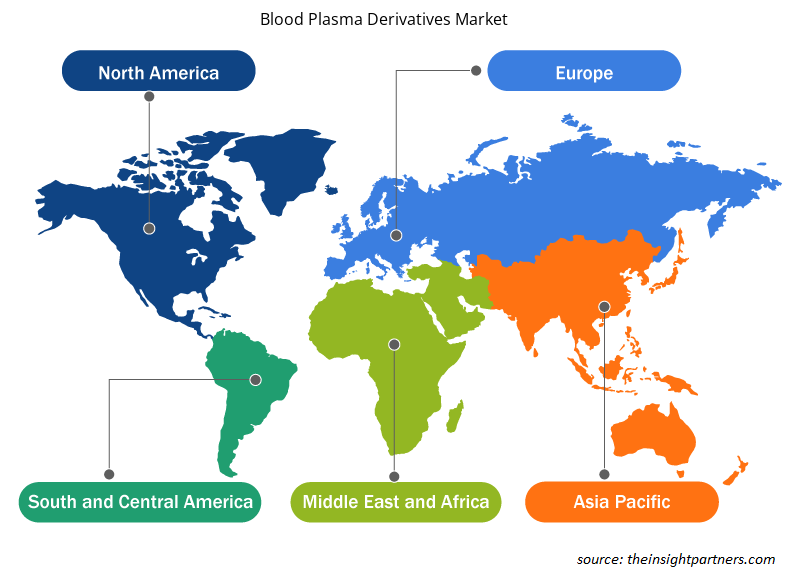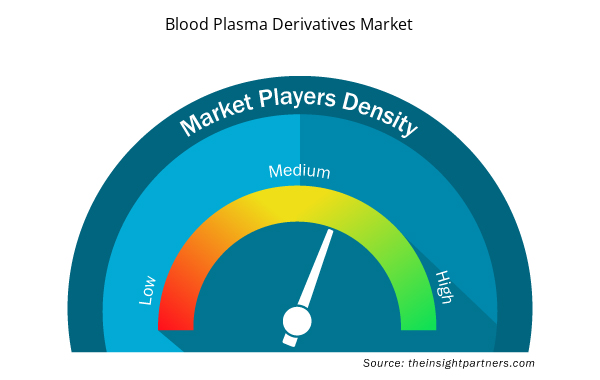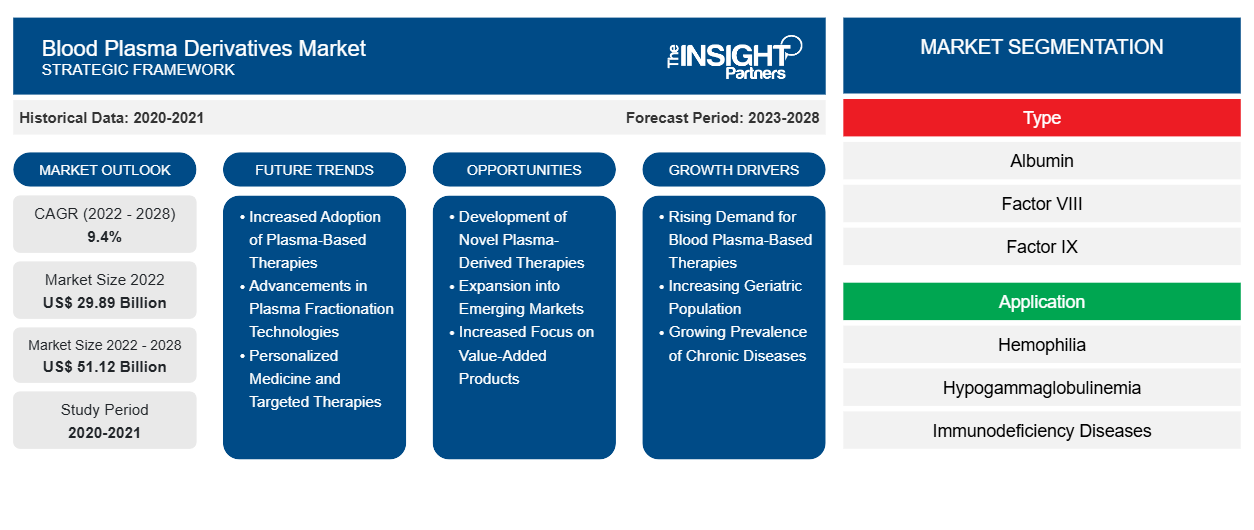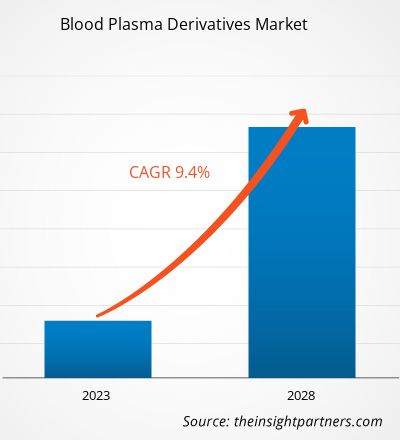[Rapporto di ricerca] Si prevede che il mercato dei derivati del plasma sanguigno raggiungerà i 51.119,24 milioni di dollari entro il 2028, rispetto ai 29.886,12 milioni di dollari del 2022; si stima che registrerà un CAGR del 9,4% dal 2022 al 2028.
I derivati del plasma sono ottenuti da proteine plasmatiche esplicite mediante il ciclo di frazionamento. I derivati del plasma sanguigno contengono un'elevata quantità di proteine, sali, minerali, ormoni, vitamine e inibitori della proteasi. Pertanto, sono comunemente utilizzati per distruggere i virus che scatenano disturbi emorragici, epatite B, epatite C, emofilia A, immunodeficienza, ipogammaglobulinemia, emofilia B e virus dell'immunodeficienza umana.
Il mercato dei derivati del plasma sanguigno è segmentato in base a tipo, applicazione, utente finale e area geografica. In base all'area geografica, il mercato è ampiamente segmentato in Nord America, Europa, Asia Pacifico, Medio Oriente e Africa e Sud e Centro America. Il rapporto offre approfondimenti e analisi approfondite del mercato, sottolineando parametri quali tendenze di mercato, progressi tecnologici e dinamiche di mercato, insieme all'analisi del panorama competitivo dei principali attori del mercato mondiale.
Personalizza questo report in base alle tue esigenze
Riceverai la personalizzazione gratuita di qualsiasi report, comprese parti di questo report, o analisi a livello nazionale, pacchetto dati Excel, oltre a usufruire di grandi offerte e sconti per start-up e università
- Scopri le principali tendenze di mercato in questo rapporto.Questo campione GRATUITO includerà analisi di dati che spaziano dalle tendenze di mercato alle stime e alle previsioni.
Approfondimenti di mercato – Mercato dei derivati del plasma sanguigno
L'aumento dell'uso dell'immunoglobulina G in molteplici trattamenti offrirà opportunità al mercato dei derivati del plasma sanguigno nei prossimi anni
Le terapie con immunoglobuline G (IgG) sono ampiamente utilizzate per trattare l'immunodeficienza primaria causata da difetti genetici. La domanda di IgG è aumentata costantemente negli ultimi anni a causa della crescente consapevolezza della terapia con IgG. Sulla base di studi controllati condotti da Network Meta Analysis (NMA), la terapia con IgG è stata approvata per il trattamento della sindrome di Guillain-Barré (GBS), della polineuropatia demielinizzante infiammatoria cronica (CIDP), della neuropatia motoria multifocale (MMN) e della dermatomiosite. Le terapie con IgG sono efficaci anche per il trattamento delle esacerbazioni della miastenia grave e della sindrome della persona rigida. Inoltre, fornisce un'efficacia convincente nei disturbi autoimmuni come epilessia, neuromielite ed encefalite autoimmune.
- Nel 2022, Grifols ha stipulato un accordo con Canadian Blood Services. Questo accordo accelera l'autosufficienza di immunoglobuline per il Canada. In base all'accordo, Grifols collaborerà con Canadian Blood Services per aumentare gradualmente l'approvvigionamento di plasma in Canada per raggiungere volumi pari a 2,4 milioni di grammi di medicinali Ig all'anno entro il 2026.
- Nel 2021, la Food and Drug Administration (FDA) ha approvato Cutaquig per uso medico. È utilizzato come terapia sostitutiva per l'immunodeficienza umorale primaria (PI) negli adulti e nei pazienti pediatrici di età pari o superiore a 2 anni. Cutaquig è una soluzione di immunoglobuline pronta all'uso per infusione sottocutanea. Il prodotto è disponibile in fiale monouso da 1 g, 1,65 g, 2 g, 3,3 g, 4 g o 8 g.
- Ad agosto 2020, Kedrion Biopharma (Italia) ha iniziato a migliorare un trattamento plasma-inferito per il trattamento dei pazienti COVID-19. Il trattamento potrebbe essere accessibile ai pazienti in tre o mezzo anni.
Una grande percentuale di IgG è utilizzata in specialità diverse dall'immunologia, come oncologia, neurologia, ematologia e reumatologia. Rispetto a tutte, la neurologia è la specialità in più rapida crescita nel mercato globale. La crescita del mercato delle immunoglobuline G è attribuita alla sua approvazione per l'uso on-label per la polineuropatia demielinizzante infiammatoria cronica (CIDP), seguita dal suo uso off-label nelle immunodeficienze secondarie causate da linfoma, mieloma e leucemia e da alcune terapie immunosoppressive, in particolare le terapie mirate alle cellule B. Pertanto, l'ampia gamma di utilizzo delle IgG in molteplici trattamenti per prescrizioni on-label e off-label stimolerà la domanda di IgG in tutto il mondo nei prossimi anni.
Informazioni per l'utente finale
In base all'utente finale, il mercato globale dei derivati del plasma sanguigno è segmentato in ospedali, cliniche e altri. Il segmento ospedaliero ha detenuto la quota di mercato maggiore nel 2022 e si prevede che registrerà il CAGR più elevato durante il periodo di previsione. Si prevede che il numero crescente di ricoveri ospedalieri e una crescente prevalenza della malattia di von Willebrand, dei disturbi da immunodeficienza e dell'emofilia guideranno la crescita del mercato per il segmento ospedaliero durante il periodo di previsione. Inoltre, le nazioni emergenti stanno assistendo a un'enorme domanda di strutture ospedaliere avanzate per far fronte al crescente bacino di pazienti e alle crescenti preoccupazioni per la salute pubblica. Inoltre, negli ospedali vengono condotte varie terapie sostitutive delle immunoglobuline per osservare le dosi e gli eventi avversi correlati alla terapia e per monitorare i risultati clinici del prodotto. Gli ospedali sono centri primari per la fornitura di terapie sostitutive delle immunoglobuline, che vengono sviluppate utilizzando nuove tecnologie. I pazienti che ricevono terapie con immunoglobuline negli ospedali percepiscono i vantaggi di una maggiore sicurezza, un monitoraggio più attento e il supporto da parte di professionisti sanitari ed esperti. Pertanto, si prevede che i vantaggi offerti dagli ospedali, come un'adeguata assistenza incentrata sul paziente e la disponibilità di strutture di rimborso, alimenteranno la crescita del mercato per il segmento durante il periodo di previsione.
Lanci di prodotti e fusioni e acquisizioni sono tra le strategie più adottate dai player del mercato globale dei derivati del plasma sanguigno. Di seguito sono elencati alcuni dei recenti sviluppi chiave dei prodotti:
- Ad aprile 2022, Grifols ha annunciato il completamento dell'acquisizione del 100% del capitale azionario di Tiancheng (Germania) Pharmaceutical Holdings AG. Tiancheng (Germania) Pharmaceutical Holdings AG è una società tedesca che detiene l'89,88% delle azioni ordinarie e l'1,08% delle azioni privilegiate di Biotest AG. Dopo il completamento dell'offerta pubblica di acquisto (PTO) e la chiusura dell'acquisizione, Grifols controlla il 96,20% dei diritti di voto e detiene il 69,72% del capitale azionario di Biotest AG.
Approfondimenti regionali sul mercato dei derivati del plasma sanguigno
Le tendenze regionali e i fattori che influenzano il mercato dei derivati del plasma sanguigno durante il periodo di previsione sono stati ampiamente spiegati dagli analisti di Insight Partners. Questa sezione discute anche i segmenti e la geografia del mercato dei derivati del plasma sanguigno in Nord America, Europa, Asia Pacifico, Medio Oriente e Africa e America meridionale e centrale.

- Ottieni i dati specifici regionali per il mercato dei derivati del plasma sanguigno
Ambito del rapporto di mercato sui derivati del plasma sanguigno
| Attributo del report | Dettagli |
|---|---|
| Dimensioni del mercato nel 2022 | 29,89 miliardi di dollari USA |
| Dimensioni del mercato entro il 2028 | 51,12 miliardi di dollari USA |
| CAGR globale (2022 - 2028) | 9,4% |
| Dati storici | 2020-2021 |
| Periodo di previsione | 2023-2028 |
| Segmenti coperti | Per tipo
|
| Regioni e Paesi coperti | America del Nord
|
| Leader di mercato e profili aziendali chiave |
|
Densità degli attori del mercato: comprendere il suo impatto sulle dinamiche aziendali
Il mercato dei derivati del plasma sanguigno sta crescendo rapidamente, spinto dalla crescente domanda degli utenti finali dovuta a fattori quali l'evoluzione delle preferenze dei consumatori, i progressi tecnologici e una maggiore consapevolezza dei benefici del prodotto. Con l'aumento della domanda, le aziende stanno ampliando le loro offerte, innovando per soddisfare le esigenze dei consumatori e capitalizzando sulle tendenze emergenti, il che alimenta ulteriormente la crescita del mercato.
La densità degli operatori di mercato si riferisce alla distribuzione di aziende o società che operano in un particolare mercato o settore. Indica quanti concorrenti (operatori di mercato) sono presenti in un dato spazio di mercato in relazione alle sue dimensioni o al valore di mercato totale.
Le principali aziende che operano nel mercato dei derivati del plasma sanguigno sono:
- Grifols SA
- SK Plasma Co Ltd
- Azienda
- Monobind Inc
- Intas Pharmaceuticals Ltd
Disclaimer : le aziende elencate sopra non sono classificate secondo un ordine particolare.

- Ottieni una panoramica dei principali attori del mercato dei derivati del plasma sanguigno
Derivati del plasma sanguigno – Segmentazione del mercato
In base al tipo, il mercato dei derivati del plasma sanguigno è segmentato in albumina, fattore VIII, fattore IX, immunoglobulina, globulina iperimmune e altri. Il mercato per il segmento delle immunoglobuline è ulteriormente segmentato in IgG, IgM, IgA, IgD e IgE. In base all'applicazione, il mercato dei derivati del plasma sanguigno è segmentato in emofilia, ipogammaglobulinemia, malattie da immunodeficienza, malattia di von Willebrand e altre applicazioni. Il mercato, in base all'utente finale, è segmentato in ospedali, cliniche e altri. In base all'area geografica, il mercato dei derivati del plasma sanguigno è suddiviso in Nord America (Stati Uniti, Canada e Messico), Europa (Francia, Germania, Regno Unito, Italia, Spagna e resto d'Europa), Asia Pacifico (Cina, Giappone, India, Australia, Corea del Sud e resto dell'Asia Pacifico), Medio Oriente e Africa (Arabia Saudita, Sudafrica, Emirati Arabi Uniti e resto del Medio Oriente e dell'Africa) e Sud e Centro America (Brasile, Argentina e resto del Sud e Centro America).
Profili aziendali – Mercato dei derivati del plasma sanguigno
- Grifols, SA
- Azienda: SK Plasma Co., Ltd.
- Assistenza sanitaria di fusione
- Azienda Biotest
- Corporazione della Croce Verde
- Kedrion
- LFB SA
- Azienda
- CSL limitata
- Takeda Pharmaceutical Company Limited
- Analisi storica (2 anni), anno base, previsione (7 anni) con CAGR
- Analisi PEST e SWOT
- Valore/volume delle dimensioni del mercato - Globale, regionale, nazionale
- Industria e panorama competitivo
- Set di dati Excel



Report Coverage
Revenue forecast, Company Analysis, Industry landscape, Growth factors, and Trends

Segment Covered
This text is related
to segments covered.

Regional Scope
North America, Europe, Asia Pacific, Middle East & Africa, South & Central America

Country Scope
This text is related
to country scope.
Domande frequenti
The blood plasma derivative market is analyzed in the basis of type, application, and end use. Based on type, is segmented into albumin, factor VIII, factor IX, immunoglobulin, hyperimmune globulin, and others. The immunoglobulins segment held the largest share of the blood plasma derivative market size, and it is anticipated to register the highest CAGR.
The blood plasma derivative market majorly consists of the players such as Grifols, S.A., SK Plasma Co., Ltd., Fusion Healthcare, Biotest AG, Green Cross Corp, Kedrion, LFB S.A., Octapharma AG, CSL Limited, and Takeda Pharmaceutical Company Limited.
The factors that are driving the growth of market are increasing prevalence of blood disorders across the world followed by rising geriatric population. However, high cost of blood plasma therapy followed by complicated reimbursement policies are the major factor hampering the growth of the market.
Blood plasma is the liquid component of blood where the blood cells are suspended. It contains dissolved proteins (albumins, globulins, and fibrinogen), clotting factors, hormones, and electrolytes. Plasma maintains blood pressure and helps exchange important minerals such as sodium and potassium for maintaining the body's pH balance. Plasma derivatives are products manufactured from human plasma using plasma fractionation techniques. These derivatives include albumin, factor VIII & IX, anti-inhibitor coagulation complex (AICC), and immunoglobulins, including Rh immune globulin, alpha 1-proteinase inhibitor concentrate, and anti-thrombin III.
Trends and growth analysis reports related to Life Sciences : READ MORE..
The List of Companies - Blood Plasma Derivatives Market
- Grifols SA
- SK Plasma Co Ltd
- Octapharma AG
- Monobind Inc
- Intas Pharmaceuticals Ltd
- Fusion Health Care Pvt Ltd
- Takeda Pharmaceutical Co Ltd
- CSL Behring LLC
- LFB SA
- Kedrion SpA
The Insight Partners performs research in 4 major stages: Data Collection & Secondary Research, Primary Research, Data Analysis and Data Triangulation & Final Review.
- Data Collection and Secondary Research:
As a market research and consulting firm operating from a decade, we have published and advised several client across the globe. First step for any study will start with an assessment of currently available data and insights from existing reports. Further, historical and current market information is collected from Investor Presentations, Annual Reports, SEC Filings, etc., and other information related to company’s performance and market positioning are gathered from Paid Databases (Factiva, Hoovers, and Reuters) and various other publications available in public domain.
Several associations trade associates, technical forums, institutes, societies and organization are accessed to gain technical as well as market related insights through their publications such as research papers, blogs and press releases related to the studies are referred to get cues about the market. Further, white papers, journals, magazines, and other news articles published in last 3 years are scrutinized and analyzed to understand the current market trends.
- Primary Research:
The primarily interview analysis comprise of data obtained from industry participants interview and answers to survey questions gathered by in-house primary team.
For primary research, interviews are conducted with industry experts/CEOs/Marketing Managers/VPs/Subject Matter Experts from both demand and supply side to get a 360-degree view of the market. The primary team conducts several interviews based on the complexity of the markets to understand the various market trends and dynamics which makes research more credible and precise.
A typical research interview fulfils the following functions:
- Provides first-hand information on the market size, market trends, growth trends, competitive landscape, and outlook
- Validates and strengthens in-house secondary research findings
- Develops the analysis team’s expertise and market understanding
Primary research involves email interactions and telephone interviews for each market, category, segment, and sub-segment across geographies. The participants who typically take part in such a process include, but are not limited to:
- Industry participants: VPs, business development managers, market intelligence managers and national sales managers
- Outside experts: Valuation experts, research analysts and key opinion leaders specializing in the electronics and semiconductor industry.
Below is the breakup of our primary respondents by company, designation, and region:

Once we receive the confirmation from primary research sources or primary respondents, we finalize the base year market estimation and forecast the data as per the macroeconomic and microeconomic factors assessed during data collection.
- Data Analysis:
Once data is validated through both secondary as well as primary respondents, we finalize the market estimations by hypothesis formulation and factor analysis at regional and country level.
- Macro-Economic Factor Analysis:
We analyse macroeconomic indicators such the gross domestic product (GDP), increase in the demand for goods and services across industries, technological advancement, regional economic growth, governmental policies, the influence of COVID-19, PEST analysis, and other aspects. This analysis aids in setting benchmarks for various nations/regions and approximating market splits. Additionally, the general trend of the aforementioned components aid in determining the market's development possibilities.
- Country Level Data:
Various factors that are especially aligned to the country are taken into account to determine the market size for a certain area and country, including the presence of vendors, such as headquarters and offices, the country's GDP, demand patterns, and industry growth. To comprehend the market dynamics for the nation, a number of growth variables, inhibitors, application areas, and current market trends are researched. The aforementioned elements aid in determining the country's overall market's growth potential.
- Company Profile:
The “Table of Contents” is formulated by listing and analyzing more than 25 - 30 companies operating in the market ecosystem across geographies. However, we profile only 10 companies as a standard practice in our syndicate reports. These 10 companies comprise leading, emerging, and regional players. Nonetheless, our analysis is not restricted to the 10 listed companies, we also analyze other companies present in the market to develop a holistic view and understand the prevailing trends. The “Company Profiles” section in the report covers key facts, business description, products & services, financial information, SWOT analysis, and key developments. The financial information presented is extracted from the annual reports and official documents of the publicly listed companies. Upon collecting the information for the sections of respective companies, we verify them via various primary sources and then compile the data in respective company profiles. The company level information helps us in deriving the base number as well as in forecasting the market size.
- Developing Base Number:
Aggregation of sales statistics (2020-2022) and macro-economic factor, and other secondary and primary research insights are utilized to arrive at base number and related market shares for 2022. The data gaps are identified in this step and relevant market data is analyzed, collected from paid primary interviews or databases. On finalizing the base year market size, forecasts are developed on the basis of macro-economic, industry and market growth factors and company level analysis.
- Data Triangulation and Final Review:
The market findings and base year market size calculations are validated from supply as well as demand side. Demand side validations are based on macro-economic factor analysis and benchmarks for respective regions and countries. In case of supply side validations, revenues of major companies are estimated (in case not available) based on industry benchmark, approximate number of employees, product portfolio, and primary interviews revenues are gathered. Further revenue from target product/service segment is assessed to avoid overshooting of market statistics. In case of heavy deviations between supply and demand side values, all thes steps are repeated to achieve synchronization.
We follow an iterative model, wherein we share our research findings with Subject Matter Experts (SME’s) and Key Opinion Leaders (KOLs) until consensus view of the market is not formulated – this model negates any drastic deviation in the opinions of experts. Only validated and universally acceptable research findings are quoted in our reports.
We have important check points that we use to validate our research findings – which we call – data triangulation, where we validate the information, we generate from secondary sources with primary interviews and then we re-validate with our internal data bases and Subject matter experts. This comprehensive model enables us to deliver high quality, reliable data in shortest possible time.


 Ottieni un campione gratuito per questo repot
Ottieni un campione gratuito per questo repot